This year I had the opportunity to attend the 2023 NAMM Show (National Association for Music Merchants) in Anaheim, CA. Let me tell you, it was like drinking from the fire hose with so many cool things to see! Over three days, I joined 45,000 other attendees to witness all sorts of product debuts in the music industry.
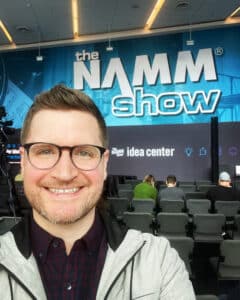
While many aspects of the show are geared more toward artists, dealers, and audio engineers, this was the first year that they offered a dedicated music educators’ track, which was fantastic for people like me! Also, if you own your own music teaching business, there are a variety of world-class sessions on marketing, social media, video, etc. For anyone looking for a different kind of conference to attend but one that is still related to music, I would highly recommend going to NAMM at least once. And, the fee for educators was only $140. Mark your calendar for January 25-28 for NAMM 2024 if you can!
Many companies wait until NAMM week to release new products and technology, so I thought this would be a great opportunity to write about all of the new things I saw and heard about and how they might impact us as music teachers (and, particularly piano teachers). I’m sure I missed some things, but these items were the most impactful new innovations in music technology that I encountered this past week.
Yamaha YH-WL500 Wireless Headphones

First up, Yamaha has just released a killer pair of YH-WL500 Wireless Headphones ideal for practicing on digital instruments. This is quite revolutionary because Bluetooth headphones have traditionally experienced noticeable latency issues when used with musical instruments. These new headphones only have a latency of 4 milliseconds compared to the standard 200 milliseconds when using Bluetooth headphones. I was told by a Yamaha sales rep at the NAMM Show that these use Wi-Fi instead of Bluetooth, and that is how a high-speed signal is achieved. They sound fantastic, feel really good on the ears, and have a battery that can last up to nine hours.
Yamaha Clavinova CVP 900 Series
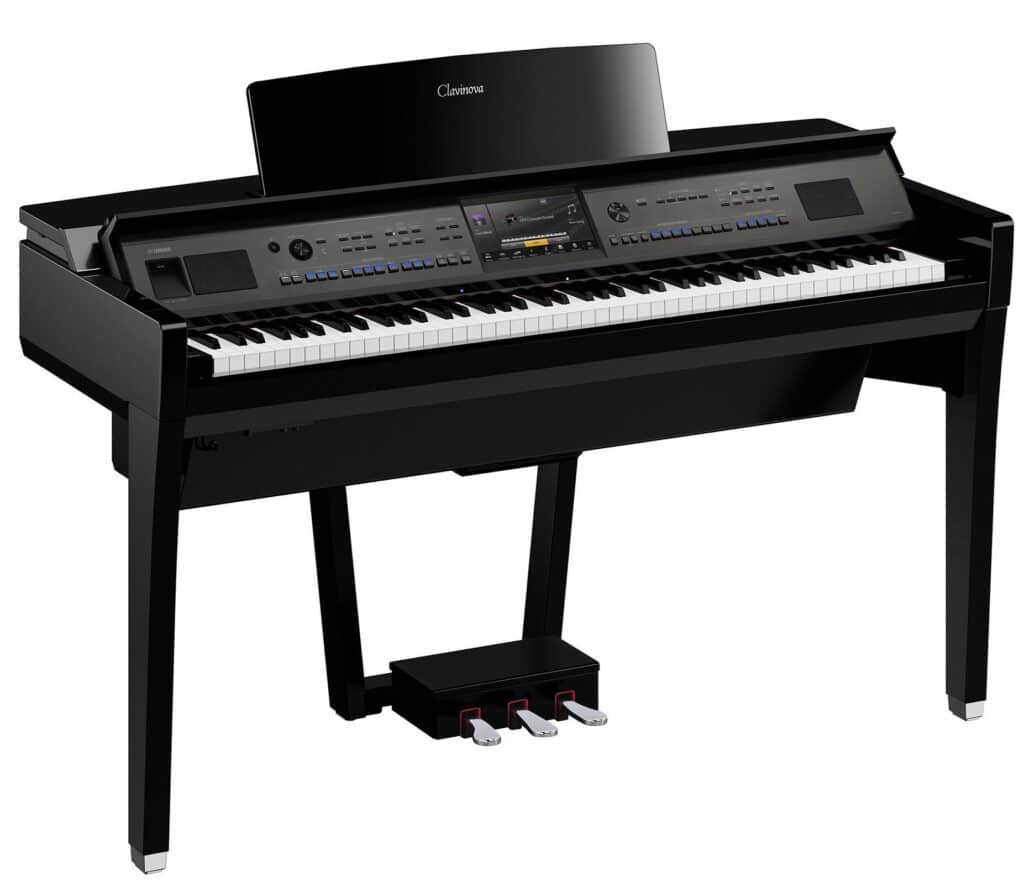
Also released by Yamaha this week was the new Clavinova 900 Series. I had a chance to sit down and play one of these incredible instruments, and my mind was blown! Yamaha keeps pushing the boundaries with their Clavinova digital pianos. This series features newly sampled piano sounds for both the Yamaha CFX and the Bösendorfer—even more realistic sounding with binaural sampling recorded from the player’s perspective.
The pianos now feature both GrandTouch action and the new GrandTouch pedals. The fulcrum of the pedal has been moved to the center instead of the end of the pedal so that it now feels nearly identical to the pedal of an acoustic piano. The instrument also features something called Grand Expression Modeling which has improved the overall touch, tone, dynamic control, and responsiveness. I could tell the difference from the very first notes I played on the instrument, and it is a noticeable improvement over the 800 series.
Also, if you’ve used a Clavinova before, you know that the follow-light feature used red and green LED lights above the keys to help people learn songs by rote. This wasn’t great for people who are color-blind! The lights have now been changed to blue and white to solve that problem.
I want one of these instruments so badly now! If you’ve been holding off on getting a Clavinova, I think the tech is reaching a high point, and you can confidently invest in one of these instruments for the longer term.
Yamaha SmartPianist App Update
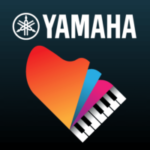
Yamaha also released an update to the SmartPianist App this week, which you can use along with most Yamaha digital piano models produced over the past few years. The new update actually made it compatible with an even wider range of piano models. One new feature is the ability to upload sheet music PDFs. I find this helpful because in the past I had to use hard copies of sheet music when recording with SmartPianist because it wasn’t possible to record in the SmartPianist App and use a score reader app like forScore at the same time. Now, I can both read digital music and record on the same device. Best of all, it’s free, and apparently, you can use one of the pedals on your Clavinova to turn pages. Very cool!
Music Stands and Learning Aids from Noisy Clan
A company called Noisy Clan has created the lightest, most portable music stand on the market. Called the Wee Stand, it is only 1 lb but can hold up to 22 lbs.
They also have some fun new visual learning aids such as the Circle of Fifths Decoder. Unlike a traditional circle of fifths, this resource highlights only the primary and related chords in a key in an uncluttered, simple-to-understand fashion. Their website says that they have a “chord patterns decoder” coming soon, which I’m even more interested in seeing! This company received a “Gotta Stock It” Award at the NAMM Best in Show for their Circle of Fifths Decoder.
Yamaha P-S500
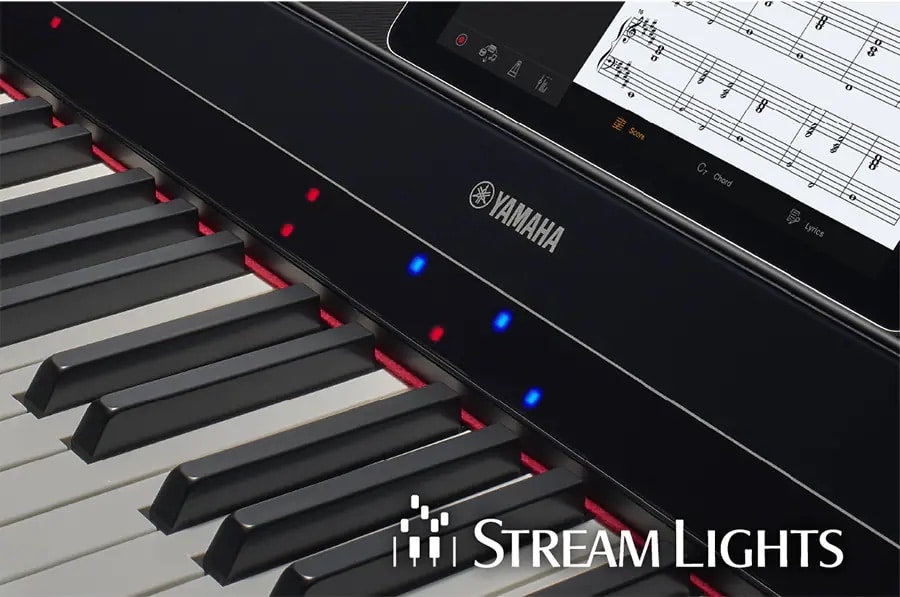
Yamaha’s new P-S500 has a play-by-light feature called Stream Lights, and I haven’t seen anything like it on the market until now. You’ve probably noticed those YouTube videos with the little lights that come down to the keys to help people learn songs by rote—the concept is very similar. Although I didn’t have such great luck using the Stream Lights with quicker, syncopated songs like “Dancing Queen,” it did work pretty well with something slow and simple like “My Heart Will Go On.” The red lights represent white keys and the blue lights represent black keys, but it was a little hard to keep them all straight. I probably won’t be using this as a music teacher, but I still wanted to share this because the tech is definitely new and interesting, and we may eventually see more pianos with LED screens running the full length of the piano. Just FYI!
Eminent Technology Model Twenty Guitar Speaker

Eminent Technology has produced the first flat-panel guitar speaker cabinet. It weighs 21 pounds and is only 2.5 inches thick. How is this possible? Will we eventually see piano amplifiers like this? Is this the future of speakers? The Model Twenty definitely packed a powerful punch and got a Best in Show Award at NAMM.
Gator Frameworks GFW-KEYSUSTAIN Keyboard Pedal
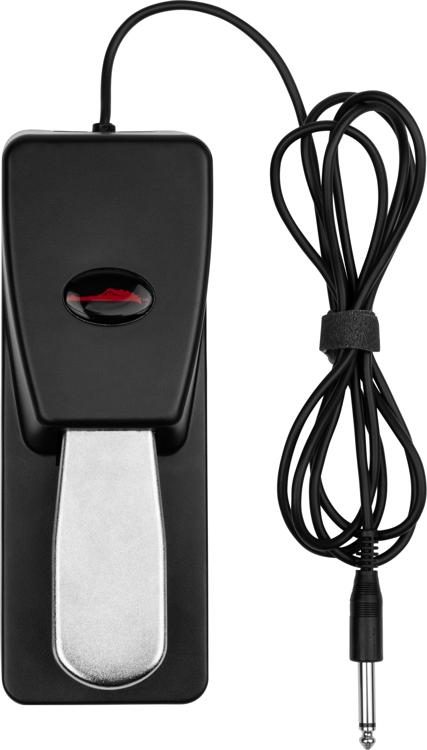
Remember how I mentioned that Yamaha’s new Clavinova has an improved sustain pedal that feels like a real acoustic piano? Well, Gator Frameworks has developed a stand-alone keyboard pedal that achieves a similar result. On a side note, Kawai has also updated their pedal technology on their new CA401 and CA501 digital pianos, indicating that more realistic keyboard pedal technology is becoming the industry standard.
Yamaha TC3 TransAcoustic Piano
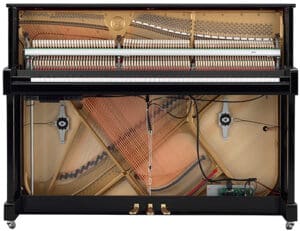
Yamaha also just released a new version of the TransAcoustic Piano for compact upright models. Until now, TransAcoustic was only available in grand pianos and taller uprights. This is good news as there will be a more affordable entry point into the TransAcoustic world.
If you are unfamiliar with Yamaha’s TransAcoustic piano, it is basically the marriage between a digital and an acoustic piano. You can play the piano as a fully functioning acoustic piano, or you can disengage the hammers and switch to digital mode. While in digital mode, you can either practice silently with headphones, or you can use the piano’s acoustic soundboard (by way of a transducer) as a speaker for the digital sounds. You can even mix the acoustic piano with digital sounds. For example, you could play acoustic piano with digital strings. It’s amazing technology, and although not completely new, this new model might mean I can finally afford one!
Casio Privia PX-S7000 Mid-Century Modern Keyboard
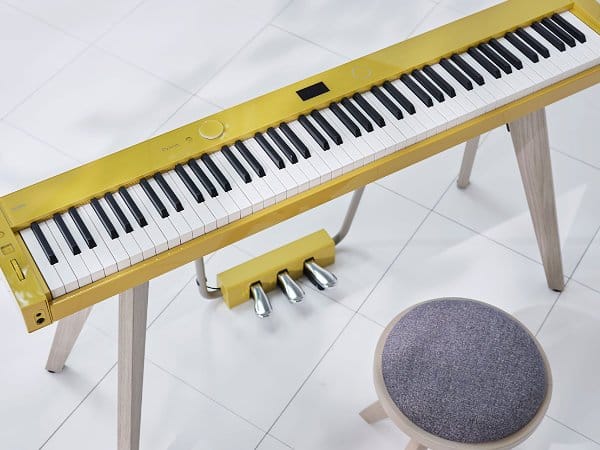
Casio has launched the new Casio Privia PX-S7000, which has a mid-century flair. I heard rumors that these pianos were selling like hotcakes, but they come at a fairly hefty price tag starting at $2,499.00. They do have more affordable models without the fancy mid-century case, but they all appear to be a bit more expensive than comparable Yamaha models, so I had to try one out and see what all the hype was about!
After playing the Casio Privia, I can say that it is a decent instrument, but I still remain partial to the sound and touch of a few other brands—others might disagree with me. If you have students looking for a basic weighted keyboard, I would steer them toward other options like Kawai, Roland, or Yamaha. From a design perspective, it is a beautiful instrument!
Steingraeber Technological Advancements
I had the very fortunate opportunity to play a Steingraeber piano for the very first time. In all honesty, their upright pianos were some of the most beautiful I have ever played. I had not heard of this company, and probably for a good reason, since they are quite small. They do have quite a history!
The original Steingraeber founder was Franz Liszt’s piano technician, and he later started a piano manufacturing company that supplied pianos to Liszt. Today, they only produce around 100 pianos per year (50 upright pianos and 50 grand pianos). They have U.S. dealers only on the West Coast, East Coast, and in Chicago. I was able to chat with a 7th-generation direct descendant of the Steingraeber family. She shared several amazing innovations they have been able to experiment with due to their small size.
The coolest features were the Mozart Rail and the Sordino. The Mozart Rail lowers the key depth to imitate a Viennese piano action. It also produces a much quieter tone. Check out the video!
The Sordino is a mute stop that places a felt rail on the strings. It was particularly lovely for special moments in Debussy! A small group of people surrounding the piano kept returning to the comment: “How is this innovation practical if there are so few of them in the world?” Ha ha! So true, but the effects were fascinating nonetheless, and good for them for charting new territory in the fairly canonized industry of acoustic pianos! Here is footage of the Sordino.
Excitement for What the Future Holds
What will a musical instrument be in 10 years? Who knows!? Just like technological advancements continue to accelerate in our everyday lives, we are seeing significant innovations in music technology each year. Even if we don’t use ALL of this technology, it is important, and quite fascinating, to know what is changing in our musical world. We have to stay interested, relevant, and ready to explore all that is to come. I’m super excited to see what’s next, and I hope you are, too!
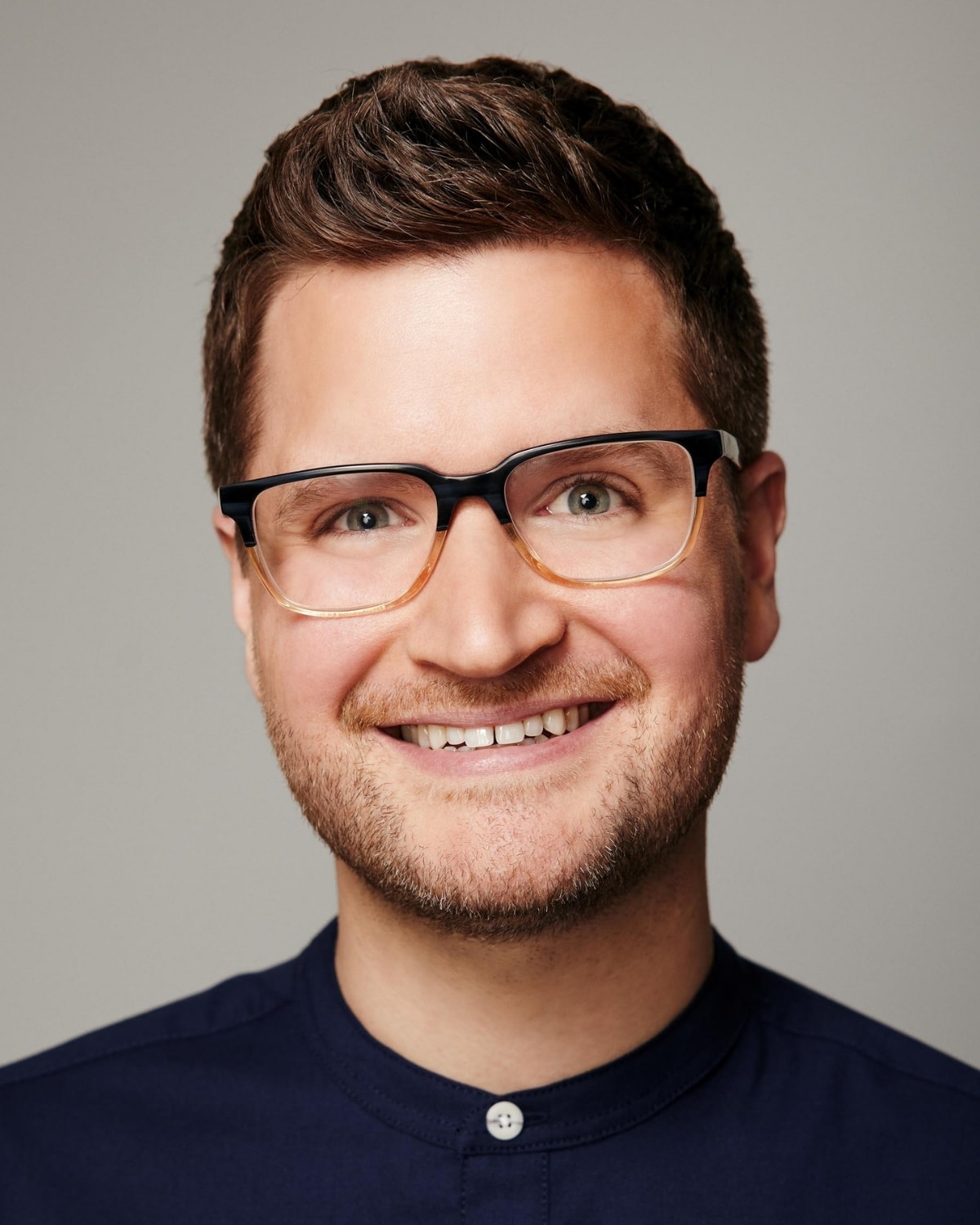
A passionate music educator, presenter, and author, Davis spends his days empowering music students through creative teaching and music education resources. He is a frequent presenter at conferences and workshops across the nation and is co-author of the Easy Piano Lead Sheets and Chord Charts series. He currently lives in Cincinnati, Ohio.

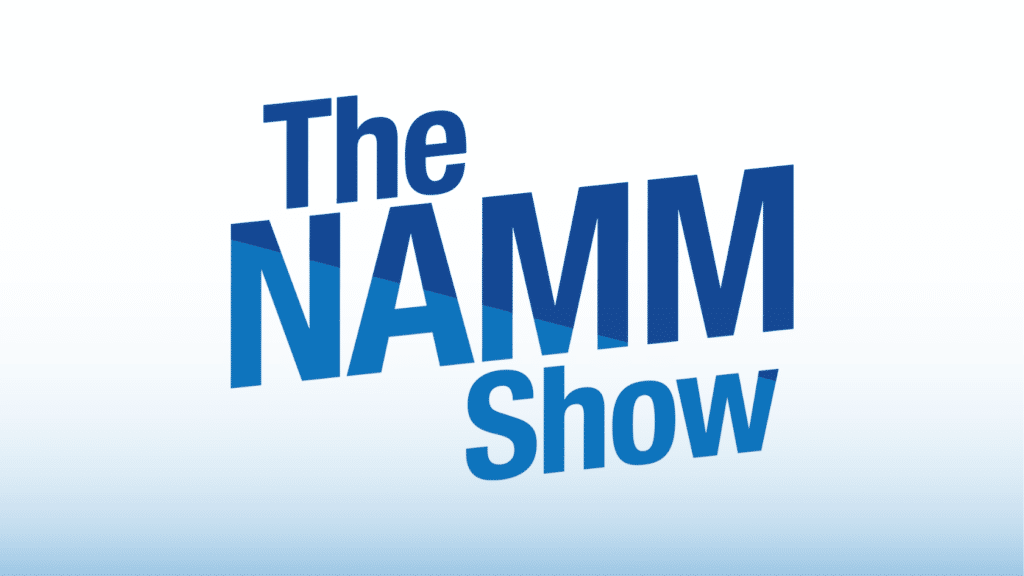


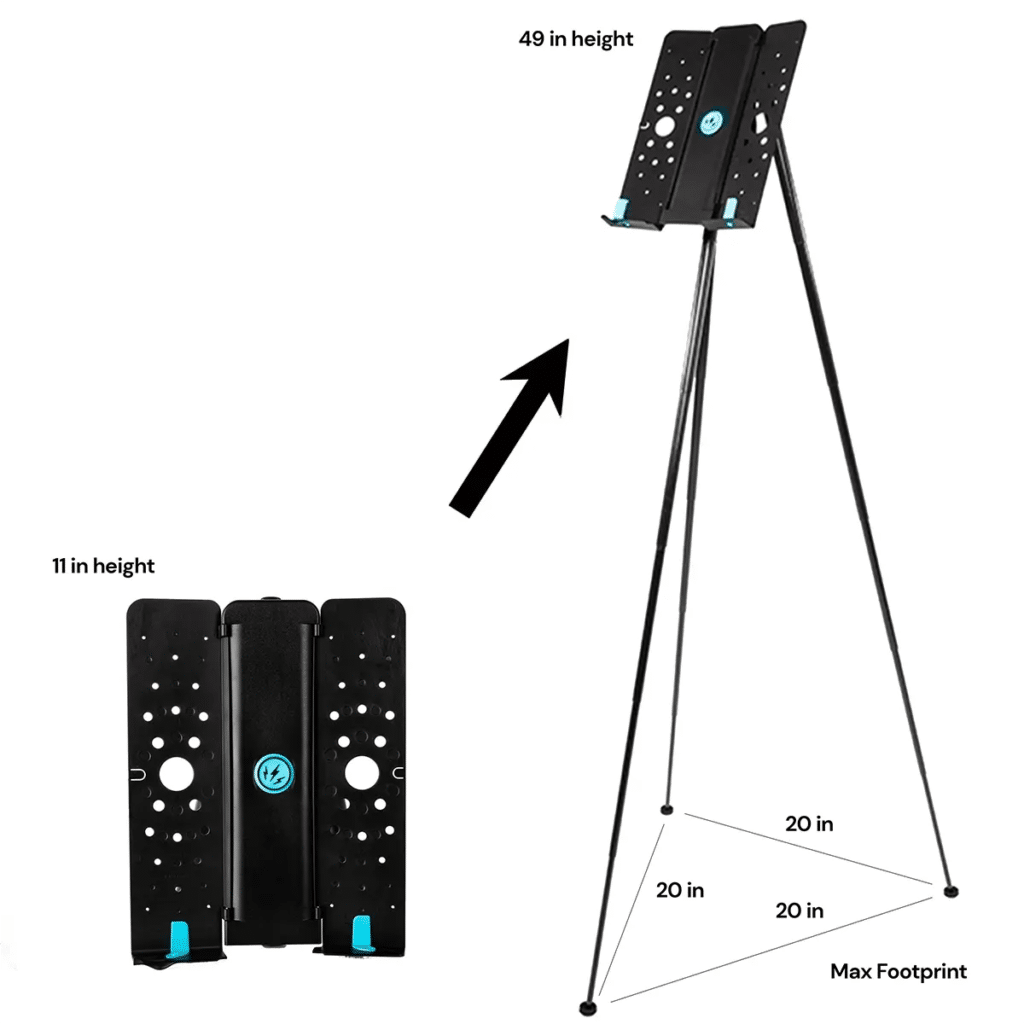



Pingback: Friday Finds #261 - Piano Pantry